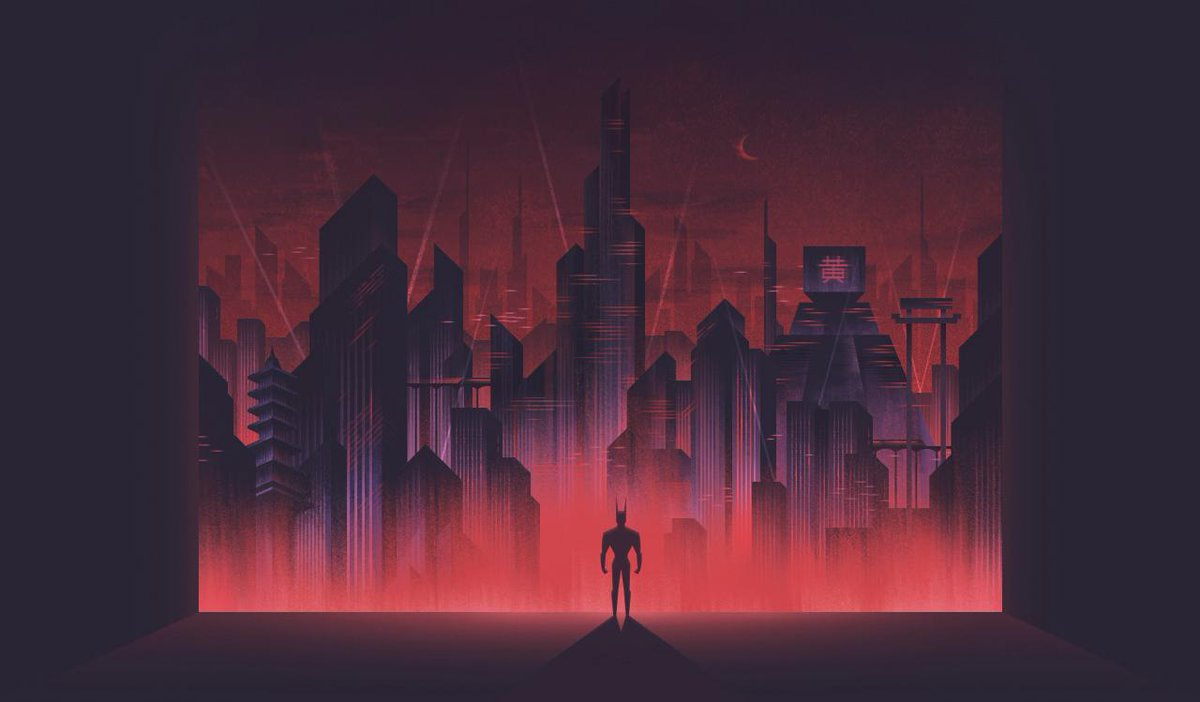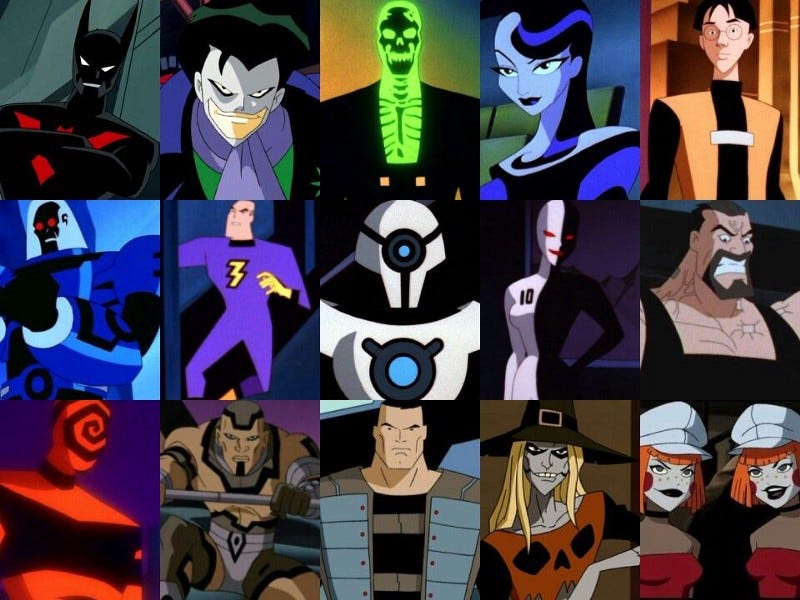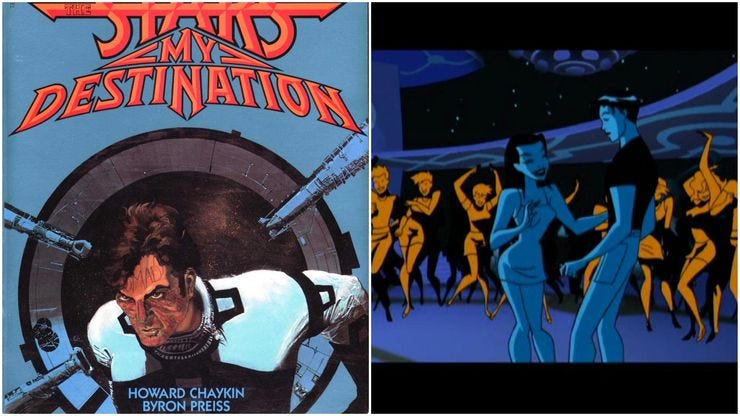Metropolis Monday
Hi there, and welcome to Engineering Our Social Vehicles! I’m your host, Paul Logan. Today is Metropolis Monday. If you’re new around here, that means that on Mondays we like to talk about cyberpunk works in the lineage of the classic 1927 film Metropolis. Today, we’re going to talk about Batman Beyond.
Disclaimer (Publication Date): This article was upcycled from my old Medium blog, and as such the writing style may be a bit jarring for newer readers.
Cyberpunk Canon
If you asked me for a 5-point cyberpunk canon, here is what I would give you: Neuromancer, Snow Crash, Blade Runner, Cowboy Bebop, and Akira with honorable mention to Daemon and Transmetropolitan. If you asked me a second time, and said “but really”, Batman Beyond would be the first thing out of my mouth. For nearly two decades I’ve stood silent, too embarrassed to list it along such other legendary and beloved media properties. No longer- Batman Beyond is a cyberpunk masterpiece, and I’m tired of pretending it’s not.
The original Batman: The Animated Series is a beloved hallmark of Animated Cinema and culture. Why not Batman Beyond? It has all the complexity of character, situation, society, and identity that the original series had in spades. And it does it all while paying homage to the original series, as if the writers had sat through each and every scene diligently scribbling notes (Rather than blatantly copy pasting plot).
Batman Beyond, however, also has all the hallmarks of a piece of cyberpunk canon:
Rogue AI spawned from a demented billionaire’s quest for immortality.
Thugs holding up a cybernetics surgeon to get free mods which they then use to do 🔥CRIMES🔥.
Young athletes get addicted to a powerful new form of steroid that can double your strength in minutes (which they then use to do 🔥crimes🔥).
Half-animal half-human hybrid cult (The 🐍Splicers🐍).
Boy and 5 story tall autonomous construction robot become psionically connected, boy uses said robot to get revenge on his bully.
Cybernetic supersuit.
A highschool virgin buys a fully functioning fembot android off the internet.
Flying cars with doors that go like this: \ /
Massive skyscrapers that disappear into a layer of smog.
Megacorps with cool names like Wayne Powers Industries
A sentient assault drone with the ability to project a holographic disguise of any person real or otherwise. All it wants to do is live in peace and not be used as a tool of war, but to achieve that dream it must fight. (This one spawned its own show).
Full body immersive VR that is so real people become literally addicted to it and attempt to spend their whole lives in it, basically becoming junkies.
Holographic newscasts.
Floating platforms at massive cyber raves.
Femme-Fatale turned cat-burgling shapeshifter mercenary in an industrial experiment gone awry.
Weaponized sound in a cool suit that makes you look like a polar bear.
Cyberpunk Setting
This is not a bright, happy world. This world has grime, this world has crime, this world has layers of history and tragedy that stack up from the foundations of the city itself. The mechanical design and technology present in Gotham, along with the new styles and fashions seen being worn by different segments of society- from the destitute to the criminal to the partiers to bourgeoisie- show a lot of thought and intention behind them. For example, The costumes were designed after The Stars My Destination- a granddaddy cyberpunk influence.
(I’m curious about the decision to largely ignore the spikey-haired techno-punks getting mudded in Frank Miller’s The Dark Knight Returns, though elements of their style show up here and there.)
The mechanics of cars, elevators, doors, even student’s lockers have been updated to a consistent technological standard that feels real (everything in the universe uses keycards, even money)- the interior of the Batmobile feels tech-y without resorting to gimmick. Everything looks like it has a use.
Indeed, the show is comfortable enough in its own skin to give us offbeat episodes like Joy Ride which give us glimpses into the operations of the military and its technology through the hilarious lens of out of control teens; and Heroes, which does a spot on The Boys impression.
MORE!
This world lives, this world breathes. It was compelling enough for companion shows to be influenced into crossover events in which the world outside of Gotham was surprisingly… normal. I’m not sure how to interpret this beyond differences between showrunners.
It is the longest piece of cyberpunk media you haven’t consumed. I periodically rewatch it, about every three years or so, because of how stellar a television show it was. I can’t recommend it enough, which brings me to my most important point, and the reason I’m writing the article.
I want more content in this universe. It’s interesting, it’s compelling, and now more than ever its setting is relevant to current discussions around society.
I didn’t know when I was watching it as a child, but the show sparked an enduring love of cyberpunk that has me still writing short stories in my late 20’s.
A few ideas for storylines that could tie into current properties but also be unique and compelling on their own:
Has the court of owls lasted through all this time? What does a techno-talon look like
What other characters might exist in this universe? I would sell my left kidney to have the HBO Harley Quinn team on something like this.
Exploring Bruce Wayne or someone similar through the conflict of having to run a MegaCorp while simultaneously foiling their evil plots at night- this was present in the original series, but not always in spades.
Cyberpunk and Social Commentary
Does Batman Beyond have enough self awareness in its social commentary to qualify as a significant work of cyberpunk media? I think yes.
Bruce Wayne has always been a billionaire, at odds from the common man. He swoops down from his mansion every night and cripples people on welfare for committing petty crimes. It’s not a good look. Terry is an everyman. He has enough complication for us to believe him as a character and find empathy for his situation: single mom, younger brother he’s trying to parent, shitty job — he’s trying to make the world a better place for people like him, not impose his will onto a spineless society (of course Batman would have become popular around the time of the “Great Men” period in historical discourse. 😛) This flips the entire narrative of Batman on its head and casts the biggest villains in the series as white collar criminals (also very cyberpunk).
Batman Beyond, however, is curiously mum about the state of political power in its society. Obviously the rich still seem to have power, but the police still exist. Gotham is filled with MegaCorps, but they don’t seem to be anything but a reskinned version of the warehouses and manufacturing plants the original Batman was always chasing villains into.
Why is that, I wonder? Often times the moral seemed to point at one or two individuals turning the levers of power, applying the downward pressure of evil. Maxwell Powers is a so-so nemesis that becomes almost sympathetic in the end due to his desire to just be left alone.
But what of his company and board who no doubt profited from his outrageous actions? They are shown to be sycophants, incompetent stammerers in the face of Maxwell’s rage. In this way, Batman Beyond hoists the societal weight from the shoulders of the collective onto the back of a scapegoat. The machinery of society in Batman Beyond is obviously broken, the rich enjoying fabulous lives of luxury while the poor live in the literal gutters under them, harassed by roving gangs of ne’er-do-wells and well-to-dos. Sound familiar at all?
Conclusion
I think that perhaps there isn’t as much room as one would like for social commentary in a children’s TV show about a man who flies around with jet boots and bat wings. The decisions to hold up the mirror to the startling inequity in Gotham still present in the future is an admirable one, and has enough merit that Batman Beyond should be cyberpunk-canonized.









